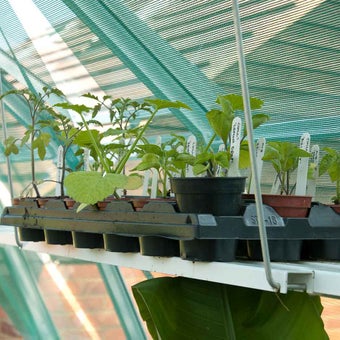
Quick facts
Suitable for - Greenhouses
Timing - Autumn to spring
Difficulty - Easy to moderate
Should I heat my greenhouse?
You don’t have to heat your greenhouse, but providing some winter warmth will help you grow a wider range of plants.
If you don’t heat your greenhouse, you can use it to shelter half-hardy (H3) plants to increase their chances of survival over winter. Then as temperatures rise in spring, you can use it to sow and raise young plants for the garden.
If you heat your greenhouse enough to keep it frost-free (4C), you can grow more tender plants (H2) throughout the winter, and get an early start on growing warm temperate plants (H1C) in spring ( , Nicotiana, petunias, salvias, zinnias).
These categories relate to an average greenhouse in a domestic garden setting rather than a more controlled commercial growing situation.
Likewise the following heating methods and energy saving tips are also best suited to domestic greenhouses.
Electric or gas heating?
Electricity may seem costly, but electric heaters are easily controlled and are widely available. Look for one with a thermostat – while not always accurate, it gives you the ability to regulate the temperature to meet the requirements of the different plants you may want to grow. Both types of electric heater below are available with thermostat.
Keep track of temperatures
To accurately measure the temperature of your greenhouse you will need a maximum/minimum thermometer – thermostat dials may be inaccurate by a few degrees, since they are located close to the heater itself. Place your thermometer in the middle of the greenhouse, close to where most of the plants are, to get a more accurate measure of the temperatures the plants are experiencing.
Types of electric heaters:
- Fan heaters – these provide more heat and improve air circulation to avoid cold corners and provide a more even heat. Buy one specifically sold for greenhouses to ensure safety.
- Tube heaters – these are lower energy than fan heaters and provide background heat to help keep frost at bay.
Make sure the electrical connection to the greenhouse is to ensure safety.
Eco-tariffs
Most domestic household electricity suppliers offer eco-tariffs, which provide green electricity from renewable sources. Using one of these will heat your greenhouse reduces your carbon footprint.
Gas or paraffin can be useful where it’s not possible to install an electrical supply, such as on an allotment. Burning these fuels produces water, and carbon monoxide, which means the greenhouse needs ventilating to avoid build-up of combustion products. This reduces the heating effect, meaning these heaters are only really useful for plants that can withstand quite low temperatures ( H2 or hardier ). These fuels are the least environmentally friendly options.
Other, more sustainable sources, such as ground source heat pumps and woodchip-fired boilers, offer the hope of more environmentally friendly options in the future. Unfortunately, for now, they are not cheap, easy to install or particularly suitable for domestic greenhouses.
How to insulate a greenhouse
The main loss of heat from greenhouses is from draughts and through the structure. The following tips should help improve the efficiency of the heating you choose, and save money in the process.
- Replace broken panes and ensure vents and doors fit snugly
- Seal cracks – transparent silicone sealant can seal quickly and easily. The flexibility of silicone means panes won’t break when the structure flexes in the wind
- Add a layer of re-used bubblewrap to insulate the greenhouse. A layer of plastic cuts out some light (about ten percent), which impacts on growth, but this is usually considered a worthwhile trade-off to keep heating bills down. This also applies to double-glazing
- Renewing seals on doors and ventilators can help but, sometimes, you might need to tape re-used clear plastic sheeting over leaking areas. However, make sure you can still ventilate the greenhouse when needed
- If you have a large greenhouse and not many plants, you can save energy by putting all your plants at one end of the greenhouse and then making a screen from bubblewrap and battens to create a smaller area to be kept heated
- Draping hessian or re-used over plants in particularly cold snaps can provide additional protection from frost
Gardening myths
Some gardeners place containers of water in the greenhouse to give off warmth as they freeze (latent heat of freezing). However, the ‘temperature lift’ they provide is negligible, and by the time the water freezes the plants may already be damaged. Choosing a heater with a thermostat is still the best option.
Problems
Damp and associated moulds and rots can be very damaging in winter, no matter how carefully plants are watered. On mild and sunny days, ventilate the greenhouse freely by opening doors and windows to reduce dampness and .
Should I bubble wrap my greenhouse?
A layer of plastic cuts out some light (about ten percent), which impacts on growth, but this is usually considered a worthwhile trade-off to keep heating bills down. This also applies to double-glazing.
Some crops, winter lettuce and alpines for example, need as much light as possible and will suffer if too much shade is cast by insulation. Avoid using materials such as bubblewrap if your plants are hardy enough to survive, as they will benefit from the light.
Keeping summer container plants over winter needs little light, but they must never freeze, so additional insulation can be worthwhile.
Many gardeners are looking for alternatives to plastics because of environmental concerns. Sadly there are no obvious transparent alternatives to bubblewrap at present, but it should be possible to re-use the same bubblewrap year after year and in some cases it is possible to recycle clean plastic at the end of its life.



